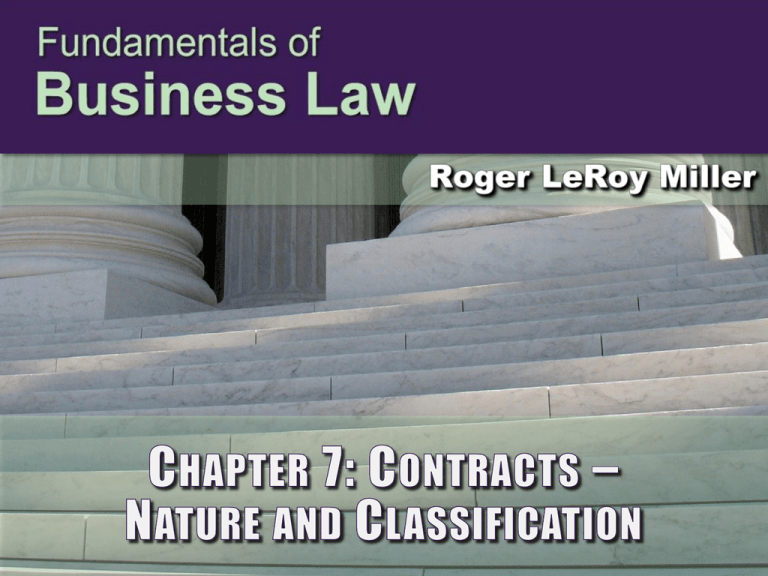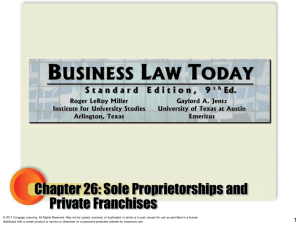
Chapter 1: Legal Ethics
1
Learning Objectives
1. What is a contract? What is the
objective theory of contracts?
2. What are the four basic elements of
a valid, enforceable contract?
3. What is the difference between an
implied contract and a quasi
contract?
© 2013 Cengage Learning. All Rights Reserved. May not be copied, scanned, or duplicated, in whole or in part, except for use as
permitted in a license distributed with a certain product or service or otherwise on a password-protected website for classroom use.
2
Learning Objectives
4. How does a void contract differ
from a voidable contract? What is
an unenforceable contract?
5. Why have plain language laws been
enacted? What rules guide the
courts in interpreting contracts?
© 2013 Cengage Learning. All Rights Reserved. May not be copied, scanned, or duplicated, in whole or in part, except for use as
permitted in a license distributed with a certain product or service or otherwise on a password-protected website for classroom use.
3
Overview of Contract Law
Sources of Contract Law.
–Common Law for all contracts except
sales and leases.
–Sale and lease contracts - Uniform
Commercial Code (UCC).
Function of a Contract.
–Provides stability and predictability for
commerce.
© 2013 Cengage Learning. All Rights Reserved. May not be copied, scanned, or duplicated, in whole or in part, except for use as
permitted in a license distributed with a certain product or service or otherwise on a password-protected website for classroom use.
4
Overview of Contract Law
Definition of a Contract.
–Promise or set of promises,
–For breach of which,
–The law provides a remedy, or
–The performance of which the law in
some way recognizes as a duty.
© 2013 Cengage Learning. All Rights Reserved. May not be copied, scanned, or duplicated, in whole or in part, except for use as
permitted in a license distributed with a certain product or service or otherwise on a password-protected website for classroom use.
5
Overview of Contract Law
Objective Theory of Contacts.
–Circumstances to determine intent of
parties.
–Objective Facts include:
• What a party said when entering into the
contract,
• How the party acted or appeared (intent may be
inferred), and
• Circumstances surrounding the transaction.
© 2013 Cengage Learning. All Rights Reserved. May not be copied, scanned, or duplicated, in whole or in part, except for use as
permitted in a license distributed with a certain product or service or otherwise on a password-protected website for classroom use.
6
Elements of a Contract
Requirements of a Valid Contract:
–Agreement (Offer & Acceptance).
–Consideration: bargained-for-exchange.
–Contractual Capacity.
–Legality: purpose of contract must be
legal at the time of execution.
© 2013 Cengage Learning. All Rights Reserved. May not be copied, scanned, or duplicated, in whole or in part, except for use as
permitted in a license distributed with a certain product or service or otherwise on a password-protected website for classroom use.
7
Elements of a Contract
Defenses to the Enforceability of a
Valid Contract:
–Voluntary Consent.
–Form: some types of contracts must be
in writing.
© 2013 Cengage Learning. All Rights Reserved. May not be copied, scanned, or duplicated, in whole or in part, except for use as
permitted in a license distributed with a certain product or service or otherwise on a password-protected website for classroom use.
8
Types of Contracts
© 2013 Cengage Learning. All Rights Reserved. May not be copied, scanned, or duplicated, in whole or in part, except for use as
permitted in a license distributed with a certain product or service or otherwise on a password-protected website for classroom use.
9
Types of Contracts
Contract Formation.
–Bilateral: Offeror accepts Offeree’s promise
to perform (“a promise for a promise”).
–Unilateral: Offeror is bargaining for
performance. Offeree accepts by completing
contract performance (“a promise for an
act”).
© 2013 Cengage Learning. All Rights Reserved. May not be copied, scanned, or duplicated, in whole or in part, except for use as
permitted in a license distributed with a certain product or service or otherwise on a password-protected website for classroom use.
10
Types of Contracts
Contract Formation.
–Unilateral Contracts.
• CASE 7.1 SCHWARZROCK V. REMOTE
TECHNOLOGIES, INC. (2011). Did the employer
owe the bonus.
• Revocation of Offers for Unilateral Contracts:
Offeror cannot revoke promise once
performance has begun, for a reasonable
time period.
© 2013 Cengage Learning. All Rights Reserved. May not be copied, scanned, or duplicated, in whole or in part, except for use as
permitted in a license distributed with a certain product or service or otherwise on a password-protected website for classroom use.
11
Types of Contracts
Contract Formation.
–Formal versus Informal Contracts.
• Formal: must be in writing to be
enforceable.
• Informal: all other contracts.
© 2013 Cengage Learning. All Rights Reserved. May not be copied, scanned, or duplicated, in whole or in part, except for use as
permitted in a license distributed with a certain product or service or otherwise on a password-protected website for classroom use.
12
Types of Contracts
Contract Formation.
–Express versus Implied Contracts.
• Express: oral or written.
• Implied: conduct creates and defines the
terms of the contract. Requirements:
• PL furnished good or service
• PL expected to be paid
• DEF had chance to reject and did not.
© 2013 Cengage Learning. All Rights Reserved. May not be copied, scanned, or duplicated, in whole or in part, except for use as
permitted in a license distributed with a certain product or service or otherwise on a password-protected website for classroom use.
13
Types of Contracts
Contract Performance.
–Executed - A contract that has been fully
performed on both sides.
–Executory - A contract that has not been
fully performed on either side.
© 2013 Cengage Learning. All Rights Reserved. May not be copied, scanned, or duplicated, in whole or in part, except for use as
permitted in a license distributed with a certain product or service or otherwise on a password-protected website for classroom use.
14
Types of Contracts
Contract Enforceability.
– Valid: agreement, consideration,
contractual capacity, and legality.
– Voidable (unenforceable): Valid contract
can be avoided or rescinded based on
certain legal defenses.
– Void Contracts: no contract was ever
formed. Neither party has any legal
obligations nor any legal rights.
© 2013 Cengage Learning. All Rights Reserved. May not be copied, scanned, or duplicated, in whole or in part, except for use as
permitted in a license distributed with a certain product or service or otherwise on a password-protected website for classroom use.
15
Quasi Contracts
Fictional, equitable remedy created
by court to avoid unjust enrichment of
one party.
–Plaintiff can recover in quantum meruit.
–CASE 7.2 SHEERER V. FISHER (2010). How
did the plaintiffs prove a valid claim for
a quasi contract?
© 2013 Cengage Learning. All Rights Reserved. May not be copied, scanned, or duplicated, in whole or in part, except for use as
permitted in a license distributed with a certain product or service or otherwise on a password-protected website for classroom use.
Quasi Contracts
Limitations on Quasi-Contractual
Recovery.
When a contract already exists, quasi
contract cannot be used.
© 2013 Cengage Learning. All Rights Reserved. May not be copied, scanned, or duplicated, in whole or in part, except for use as
permitted in a license distributed with a certain product or service or otherwise on a password-protected website for classroom use.
Interpretation of Contracts
Plain Language Laws.
–If language is clear from face of
contract, court will enforce a contract
according to plain terms.
–If language clear, court cannot
consider extrinsic evidence.
© 2013 Cengage Learning. All Rights Reserved. May not be copied, scanned, or duplicated, in whole or in part, except for use as
permitted in a license distributed with a certain product or service or otherwise on a password-protected website for classroom use.
18
Interpretation of Contracts
Plain Meaning Rule.
–If language is clear from face of
contract, court will enforce a contract
according to plain terms.
–If language clear, court cannot
consider extrinsic evidence.
© 2013 Cengage Learning. All Rights Reserved. May not be copied, scanned, or duplicated, in whole or in part, except for use as
permitted in a license distributed with a certain product or service or otherwise on a password-protected website for classroom use.
19
Interpretation of Contracts
Other Rules of Interpretation.
–What did the parties WRITE in the
contract?
–Courts will generally not remake the
contract into what the parties’ claim
their intent was when they made the
contract.
© 2013 Cengage Learning. All Rights Reserved. May not be copied, scanned, or duplicated, in whole or in part, except for use as
permitted in a license distributed with a certain product or service or otherwise on a password-protected website for classroom use.
20
Interpretation of Contracts
Other Rules of Interpretation.
–Ordinary usage of terms.
–Trade Usage, Custom, Prior Dealings.
• CASE 7.3 U.S. BANK, N.A. V. TENNESSEE
FARMERS MUTUAL INSURANCE CO. (2009). What
words in the insurance contract were most
persuasive to the court?
© 2013 Cengage Learning. All Rights Reserved. May not be copied, scanned, or duplicated, in whole or in part, except for use as
permitted in a license distributed with a certain product or service or otherwise on a password-protected website for classroom use.
21
Interpretation of Contracts
Other Rules of Interpretation.
–Ordinary usage of terms.
–Trade Usage, Custom, Prior Dealings.
• CASE 7.3 U.S. BANK, N.A. V. TENNESSEE
FARMERS MUTUAL INSURANCE CO. (2009). What
words in the insurance contract were most
persuasive to the court?
© 2013 Cengage Learning. All Rights Reserved. May not be copied, scanned, or duplicated, in whole or in part, except for use as
permitted in a license distributed with a certain product or service or otherwise on a password-protected website for classroom use.
22







